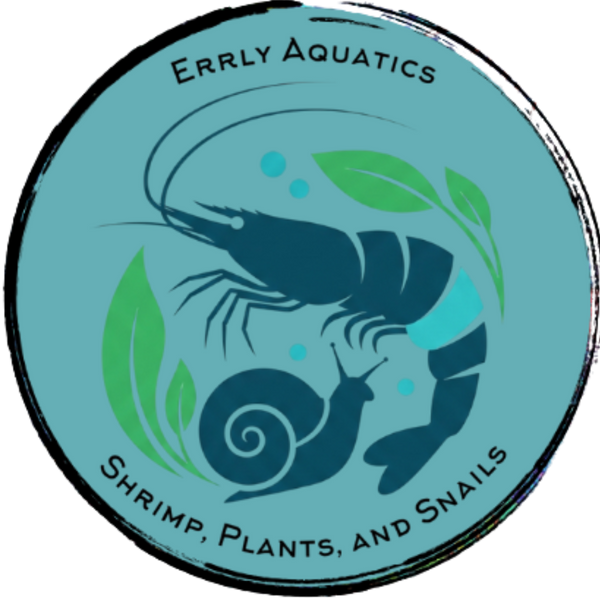
Intro to Caridina Shrimp: A Beginner’s Guide
Share
Everything you need to start & maintain healthy, colorful Caridina colonies.
Why Caridina?
Caridina shrimp, such as Crystal Reds and Bee shrimp, are prized for striking patterns and colors. They are more sensitive than Neocaridina shrimp and require stable water chemistry and a careful watch. If you're starting with Caridina, patience and stability are your best friends.
Caridina vs. Neocaridina: What’s the difference?
Caridina are the focus of this guide: they require narrower water parameters, more stable conditions, and are favored by advanced hobbyists for their color patterns. Neocaridina are generally hardier and easier for beginners. If you want a Neo-focused guide, consider keeping those species separate to avoid confusion in expectations.
(For more background on Neocaridina, see the full Errly Aquatics guide.)
Start with a Properly Cycled Tank
"Cycling" means establishing beneficial bacteria that convert ammonia → nitrite → nitrate. Never add Caridina to an uncycled tank, ammonia or nitrite spikes will stress or kill shrimp. For this guide we assume your tank is fully cycled and stable before adding shrimp.
Ideal Water Parameters
- Temperature: 68°F – 74°F
- pH: 6.0 – 6.8
- GH (General Hardness): 4 – 6 dGH
- KH (Carbonate Hardness): 0 – 2 dKH
- Ammonia & Nitrite: 0 ppm
- Nitrate: Keep below 10 ppm
Consistency is more important than perfection—sudden swings are far more harmful than a slightly imperfect but stable setup.
Feeding Caridina Shrimp
Caridina are natural grazers. Provide biofilm and supplement with high-quality shrimp-specific foods: Caridina pellets, algae wafers, powdered foods that encourage biofilm, and occasional blanched vegetables (zucchini, spinach, cucumber). Small amounts of protein can be offered sparingly to breeding adults.
Tip: Avoid overfeeding — excess food fouls the water quickly. Many keepers fast shrimp a couple days a week to reduce bio-waste and produce stronger shrimp.
Understanding Caridina Genetics
Caridina patterns and colors are the result of selective breeding. Many traits are recessive, mixing lines can dilute or muddle patterns. For consistent, high-quality color, dedicate one tank per line and selectively breed the best specimens over generations. Many breeders keep a "cull tank" for lower-grade shrimp rather than mixing them back into the main line.
Breeding Caridina Shrimp
Breeding is rewarding but requires stability. Females show a saddle (cluster of developing eggs) and after mating become "berried" (eggs under the tail). Eggs hatch in ~3–5 weeks depending on variety and temperature. Keep predators out and provide hiding places (moss, leaf litter) for juveniles. Please note that it is harder to see when a Caridina shrimp is saddled in comparison to its Neocaridina counterpart. The colors on Caridina are usually more vivid and solid making it harder to determine when a shrimp is saddled and berried.
Water Changes & Stability
Caridina are sensitive to parameter changes. Use small, gradual water changes (10–15% weekly or biweekly) with remineralized RODI water matched to tank parameters. If nitrates rise above 10 ppm, perform a careful, matched water change and consider drip acclimation for new water. Heavily planted tanks help stabilize the system.
Consistency = success. Sudden changes are more dangerous than leaving a stable tank alone.
Quick Tips & FAQ
- Less is more: avoid overfeeding; shrimp graze on biofilm most of the day.
- Use a sponge filter: shrimp-safe and excellent for beneficial bacteria and baby shrimp.
- Skip fish for now: many fish eat baby shrimp, start with a shrimp-only tank.
- Leaf litter & botanicals: Indian almond leaves and alder cones help condition water and support biofilm growth.
- Patience: shrimp breed slowly at first, give time and stability.
Common Questions
- Can I keep different shrimp colors together?
- Yes, but Caridina varieties will interbreed and can produce muddled offspring. To maintain line quality, keep one variety per tank.
- Why aren’t my shrimp breeding?
- Check stability, correct params, hiding spots, and that you have both males and females.
- Do I need a heater?
- Not always, but a heater helps maintain consistency if room temps fluctuate below 68°F.
- How many shrimp should I start with?
- Starting with 10–20 shrimp gives a good base for breeding and stability.
Shrimp Glossary
- Berried — female carrying eggs under her tail.
- Biofilm — natural microbe layer shrimp graze on.
- Cycle/Cycling — establishing bacteria to process ammonia → nitrite → nitrate.
- TDS — Total Dissolved Solids (measured with a TDS meter).
- GH — General Hardness (calcium & magnesium).
- KH — Carbonate Hardness (stabilizes pH).
- Molting — shedding an exoskeleton to grow.
- Cull — removing shrimp that don't meet breeding goals.
- Saddle — cluster of developing eggs visible before mating.
- RO/RODI — Reverse Osmosis (Deionized) water used for precise control.
Quick Troubleshooting Guide
| Problem | Probable Cause | Fix |
|---|---|---|
| Shrimp dying suddenly | Ammonia/nitrite spike, temperature shock, copper contamination | Test water (ammonia, nitrite, temp). Check additives for copper. Do small water change with matched water. |
| Not molting | Low GH (calcium) or poor diet | Adjust minerals, offer calcium-rich foods, ensure hiding spots and low stress. |
| Not breeding | Parameter instability, insufficient food, wrong sex ratio | Verify consistent params, improve diet, add hiding spots, confirm male & female presence. |
| Faded colors | Stress, poor diet, or molt | Stabilize water, feed color-enhancing foods, reduce stressors. |
DOWNLOAD THE FULL PDF CARIDINA GUIDE
Ready to start?
Buy quality, home-raised Caridina shrimp from Errly Aquatics, bred for color, health, and hardiness. Plants & snails available too. Friendly advice included.
Shop & Contact:
Shop: Shrimp
TikTok: @errlyaquatics
Email: bdallasd@gmail.com
